
Actinopterygii, members of which are known as ray-finned fish or actinopterygians, is a class of bony fish that comprise over 50% of living vertebrate species. They are so called because of their lightly built fins made of webbings of skin supported by radially extended thin bony spines called lepidotrichia, as opposed to the bulkier, fleshy lobed fins of the sister class Sarcopterygii. Resembling folding fans, the actinopterygian fins can easily change shape and wetted area, providing superior thrust-to-weight ratios per movement compared to sarcopterygian and chondrichthyian fins. The fin rays attach directly to the proximal or basal skeletal elements, the radials, which represent the articulation between these fins and the internal skeleton.
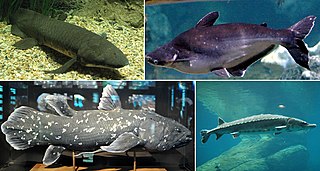
Osteichthyes, commonly referred to as the bony fish but in the 21st century also treated as a clade that includes the tetrapods, is a diverse superclass of vertebrate animals that have skeletons primarily composed of bone tissue. They can be contrasted with the Chondrichthyes, which have skeletons primarily composed of cartilage. The vast majority of extant fish are members of Osteichthyes, an extremely diverse and abundant group consisting of 45 orders, over 435 families and 28,000 species. It is the largest class of vertebrates in existence today.

Gadiformes, also called the Anacanthini, are an order of ray-finned fish that include the cod, hakes, pollock, haddock, burbot, rocklings and moras, many of which are food fish of major commercial value. They are mostly marine fish found throughout the world and the vast majority are found in temperate or colder regions while a few species may enter brackish estuaries. Pacific tomcods, one of the two species that makes up the genus Microgadus, are able to enter freshwater, but there is no evidence that they breed there. Some populations of landlocked Atlantic tomcod on the other hand, complete their entire life cycle in freshwater. Yet only one species, the burbot, is a true freshwater fish.

The burbot, also known as bubbot, mariah, loche, cusk, freshwater cod, freshwater ling, freshwater cusk, the lawyer, coney-fish, lingcod, or eelpout, is a species of coldwater ray-finned fish native to the subarctic regions of the Northern hemisphere. It is the only member of the genus Lota, and is the only freshwater species of the order Gadiformes. The species is closely related to marine fish such as the common ling and cusk, all which belonging to the family Lotidae (rocklings).

Euteleostomi is a successful clade that includes more than 90% of the living species of vertebrates. Both its major subgroups are successful today: Actinopterygii includes most extant bony fish species, and Sarcopterygii includes the tetrapods.
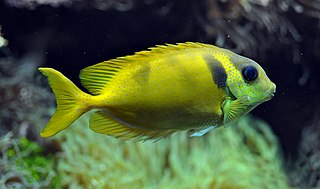
Neopterygii is a subclass of ray-finned fish (Actinopterygii). Neopterygii includes the Holostei and the Teleostei, of which the latter comprise the vast majority of extant fishes, and over half of all living vertebrate species. While living holosteans include only freshwater taxa, teleosts are diverse in both freshwater and marine environments. Many new species of teleosts are scientifically described each year.

Nitric oxide synthases (NOSs) are a family of enzymes catalyzing the production of nitric oxide (NO) from L-arginine. NO is an important cellular signaling molecule. It helps modulate vascular tone, insulin secretion, airway tone, and peristalsis, and is involved in angiogenesis and neural development. It may function as a retrograde neurotransmitter. Nitric oxide is mediated in mammals by the calcium-calmodulin controlled isoenzymes eNOS and nNOS. The inducible isoform, iNOS, involved in immune response, binds calmodulin at physiologically relevant concentrations, and produces NO as an immune defense mechanism, as NO is a free radical with an unpaired electron. It is the proximate cause of septic shock and may function in autoimmune disease.

Paracanthopterygii is a superorder of fishes. Members of this group are called paracanthopterygians.

Holostei is a group of ray-finned bony fish. It is divided into two major clades, the Halecomorphi, represented by the single living genus, Amia with two species, the bowfins, as well as the Ginglymodi, the sole living representatives being the gars (Lepisosteidae), represented by seven living species in two genera. The earliest members of the clade, which are putative "semionotiforms" such as Acentrophorus and Archaeolepidotus, are known from the Middle to Late Permian and are among the earliest known neopterygians.

Endothelial NOS (eNOS), also known as nitric oxide synthase 3 (NOS3) or constitutive NOS (cNOS), is an enzyme that in humans is encoded by the NOS3 gene located in the 7q35-7q36 region of chromosome 7. This enzyme is one of three isoforms that synthesize nitric oxide (NO), a small gaseous and lipophilic molecule that participates in several biological processes. The other isoforms include neuronal nitric oxide synthase (nNOS), which is constitutively expressed in specific neurons of the brain and inducible nitric oxide synthase (iNOS), whose expression is typically induced in inflammatory diseases. eNOS is primarily responsible for the generation of NO in the vascular endothelium, a monolayer of flat cells lining the interior surface of blood vessels, at the interface between circulating blood in the lumen and the remainder of the vessel wall. NO produced by eNOS in the vascular endothelium plays crucial roles in regulating vascular tone, cellular proliferation, leukocyte adhesion, and platelet aggregation. Therefore, a functional eNOS is essential for a healthy cardiovascular system.

The Gobiiformes are an order of fish that includes the gobies and their relatives. The order, which was previously considered a suborder of Perciformes, is made up of about 2,211 species that are divided between seven families. Phylogenetic relationships of the Gobiiformes have been elucidated using molecular data. Gobiiforms are primarily small species that live in marine water, but roughly 10% of these species inhabit fresh water. This order is composed chiefly of benthic or burrowing species; like many other benthic fishes, most gobiiforms do not have a gas bladder or any other means of controlling their buoyancy in water, so they must spend most of their time on or near the bottom. Gobiiformes means "goby-like".
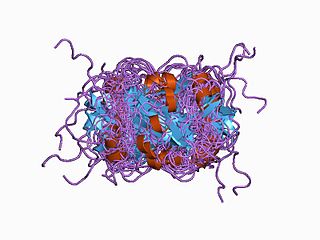
Nitric oxide synthase 1 (neuronal), also known as NOS1, is an enzyme that in humans is encoded by the NOS1 gene.

Protacanthopterygii is a ray-finned fish taxon ranked as a superorder of the infraclass Teleostei. They inhabit both marine and freshwater habitats. They appear to have evolved in the Cretaceous or perhaps late Jurassic, originating probably roughly 150 million years ago; fossils of them and the closely related Otocephala are known from throughout the Cretaceous.

Acanthomorpha is an extraordinarily diverse taxon of teleost fishes with spiny fin rays. The clade contains about one-third of the world's modern species of vertebrates: over 14,000 species.

Euteleostei, whose members are known as euteleosts, is a clade of bony fishes within Teleostei that evolved some 240 million years ago, although the oldest known fossil remains are only from the Early Cretaceous. It is divided into Protacanthopterygii and Neoteleostei.

Percomorpha is a large clade of ray-finned fish with more than 17 000 known species that includes the tuna, seahorses, gobies, cichlids, flatfish, wrasse, perches, anglerfish, and pufferfish.

Otocephala is a clade of ray-finned fishes within the infraclass Teleostei that evolved some 230 million years ago. It is named for the presence of a hearing (otophysic) link from the swimbladder to the inner ear. Other names proposed for the group include Ostarioclupeomorpha and Otomorpha.

Stomiati is a group of teleost fish belonging to the cohort (group) Euteleostei, which is a group of bony fishes within the infra-class Teleostei that evolved ~240 million years ago. Teleostei is a group of ray-finned fishes with the exception of primitive bichirs, sturgeons, paddlefishes, freshwater garfishes, and bowfins. The cohort of Euteleostei is divided into two smaller groups: the Protacanthopterygii and the Neoteleostei. Stomiati happen to be descendants of the Protacanthopterygii, and contains the order of Osmeriformes and Stomiiformes.
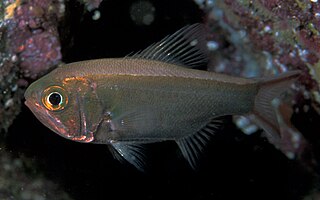
The Trachichthyiformes are an order of ray-finned fishes in the superorder Acanthopterygii.
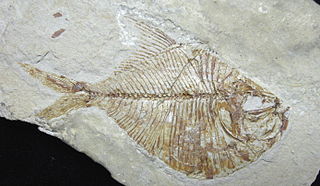
Lamprimorpha is a superorder of marine ray-finned fishes, representing a basal group of the highly diverse clade Acanthomorpha. Represented today only by the order Lampriformes, recent studies have recovered other basal fossil species of the group dating as far back as the Cenomanian stage of the Late Cretaceous. Some of these fossil taxa, such as the paraphyletic genus Aipichthys, are among the oldest known fossil acanthomorphs, and overall they appear to have been a major component of the marine fish fauna at that time. Lamprimorpha is thought to be the sister group to the superorder Paracanthopterygii, which contains cod, dories, and trout-perches.




















